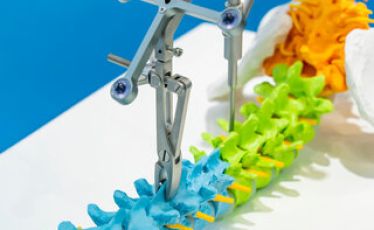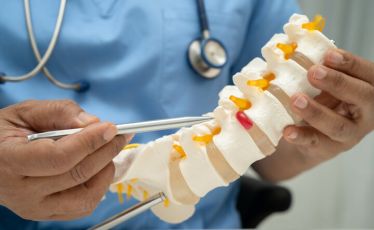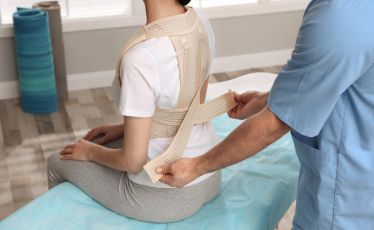+62 817-4929-054
ROBBIN: Advanced Technology for Handling Spine Problems at Premier Bintaro Hospital
Oleh: dr. Ajiantoro, Sp.OT (K) Spine, Spesialis Orthopedi dan Traumatologi RS Premier Bintaro
Spinal disease problems are very diverse and are often experienced by people. The most frequently experienced symptoms are lower back pain and neck pain. Other symptoms that are also related are the spread of pain to the feet, hands, accompanied by tingling or numbness, which is related to a pinched nerve. There are many problems with spinal diseases. One of the most common causes is a degenerative or aging process which can cause pinched nerves. Pinched nerves can occur either due to aging, problems with the spinal column which is thinning, or due to Herniated Nucleus Pulposes (HNP) or the spinal column being torn and protruding, causing pressure on the nerve.

Apart from pinched nerves, another problem that is often experienced in the spine is a disruption in the structure or shape of the spine. One of them is scoliosis or crooked back. This scoliosis problem also usually occurs in teenagers or is called Idiopathic Scoliosis. There are several other types of spinal diseases, such as infections, spinal tuberculosis, osteoporosis problems, or tumor problems in the spine.
Currently the problem of treating the spine is quite complex. 90% of spinal problems are treated conservatively or without surgery. There are many types of conservatives, such as administering medication, bone vitamins, medical rehabilitation, strengthening back muscles, physical exercise or using assistive devices such as braces or corsets, etc. Apart from that, there is also a treatment called Intervention Pain Management to reduce pain without surgery. Some IPM techniques that can be used are nerve root injection, facet joint radio frequency, and Percutaneous Laser Disc Decompression (PLDD).
However, there are also many cases where surgery is indicated, most of which are cases such as spinal instability, spinal fractures, displaced vertebrae, pinched nerves that cannot be cured with conservative treatment, or anatomical disorders such as scoliosis with a curvature above 50 degrees. . Spinal surgery techniques are also very diverse, such as spinal binoculars or endoscopy spine surgery, replacement of spinal cushions, and installation of pens or implants in the spine.
The use of pens or implants in the spine at Premier Bintaro Hospital can be handled with advanced technology using Robotic Navigation Spine Surgery, which is a new breakthrough in spinal surgical procedures, which in Southeast Asia is only available in Indonesia. This Robotic Navigation is used in spinal surgery.

Robotic Navigation Spine Surgery at Premier Bintaro Hospital called ROBBIN (Robot Bintaro) is useful for helping operators to position the pen or implant (pedical screw) accurately. This robotic surgery begins with planning on a robotic machine to determine the direction and position of the implant. After planning, the robotic navigation system can recognize the patient's body and the location of the pen or implant, so that we can perform or install the pen or implant very accurately and significantly up to 99%.
ROBBIN is often used to treat cases of structural disorders or deformities such as scoliosis or a crooked back where the shape of the spine is no longer normal, so ROBBIN can help in installing these implants. With this robot, installing implants becomes easier because you can navigate to reach the place or install them safely, remembering that the main problem in installing implants in scoliosis is that there is a risk of nerve injury if there is an error in installing the pen or implant.
Another advantage of using ROBBIN technology is that it can install implants using minimally invasive techniques or minimal incisions, especially in degenerative cases. With robotic navigation, in conditions such as degenerative disorders or aging, most people do not need open surgery or large incisions because with robotic navigation, only a small incision is made to install the implant so that the risk of bleeding and infection is smaller, and can shorten operation time and patient recovery.
Robots used in spinal surgery can be used repeatedly with very high durability without reducing performance and the risk of human error due to fatigue, thereby improving surgical results for patients.
ROBBIN has been integrated with CT scan, C-Arm 3D and Premier Bintaro Hospital is supported by 3 Tesla MRI technology. By using ROBBIN, spine surgery can be completed more safely and with shorter treatment. Because surgery with robotic technology is available at Premier Bintaro Hospital, now patients no longer need to go to another country to have surgery with this technology.
Most patients are afraid to come to see a spine orthopedic doctor because they are afraid of surgery. 90% of patients who have spinal problems do not need surgery, because they can be treated conservatively or undergo IPM. Only around 5 – 10% require surgery with appropriate indications. Patients don't need to worry, because currently with good and advanced technology, with various kinds of technology we can carry out operations safely. Premier Bintaro Hospital also has an Endoscopy Spine Surgery service, where this operation involves freeing a pinched nerve using binoculars or lenses. Endoscopic Spine Surgery is performed to treat pinched nerves, especially those that do not require implant placement, with only one day of treatment so that the patient can return to his activities.
Endoscopy is performed on pure pinched nerves without any spinal instability. However, in patients whose spine is unstable, or has scoliosis, they automatically need to stabilize the spine by installing a pen or implant called Stabilization.
With ROBBIN, significant accuracy will be produced, thereby preventing nerve injury or paralysis. Premier Bintaro Hospital also has a nerve monitoring device for cases of deformity correction such as scoliosis, namely Intraoperative Nerve Monitoring (IONM). With this tool, during surgery, the condition of the spinal nerves can be monitored every second. So, if there is an incorrect implant placement, it will be quickly detected, thereby preventing the possibility of paralysis or nerve injury.
With the advanced technology used at Premier Bintaro Hospital, operations are safer and patients can mobilize more quickly.
Premier Bintaro Hospital has the Premier Bintaro Spine Center which is a service center to treat all spinal problems in an integrated and comprehensive manner. Treatment of spinal problems is carried out by a team consisting of various specialist fields, namely Spine Orthopedic Specialists, Neurology Specialists, Neurophysiology Specialists, Medical Rehabilitation Specialists and Radiology Specialists.

dr. Ajiantoro, Sp.OT (K) Spine
Orthopedi & Traumatologi View Schedule| Loading data... |
|---|

















